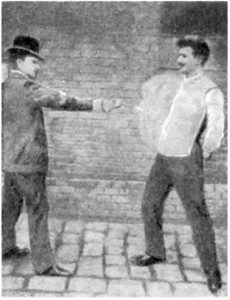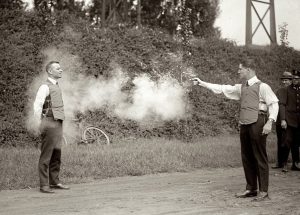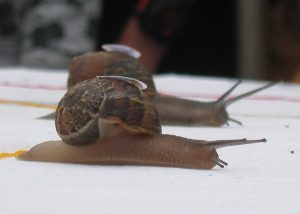Monthly Archives: October 2017

 Every new invention has to have its trial run, but some of them might not be so easy to test as others. If you are testing a Frisbee to see if it flies, it is much different than testing a plane to see if it flies. Still, an invention cannot be used, sold, and especially patented without being tested, so testing must be done, and sometimes that can be a little bit dangerous.
Every new invention has to have its trial run, but some of them might not be so easy to test as others. If you are testing a Frisbee to see if it flies, it is much different than testing a plane to see if it flies. Still, an invention cannot be used, sold, and especially patented without being tested, so testing must be done, and sometimes that can be a little bit dangerous.
For many years, police work was extremely dangerous…even more so than it is now. Without some of the protective coverings the officers have today, they could be easily killed in the line of duty…not that they can’t now, but there is a little bit less chance of it these days. Kazimierz Zeglen, was a Polish engineer, born in 1869 near Ternopol. He is credited with inventing the first bulletproof vest. In 1893, after the assassination of Carter Harrison Sr, the mayor of Chicago, he invented the first commercial bulletproof vest. In 1897, he improved it together with Jan Szczepanik who was the inventor of the first commercial bulletproof armor in 1901. It saved the life of Alfonso XIII, the King of Spain…his carriage was covered with Szczepanik’s bulletproof armor when a bomb exploded near it.
When the time came to test the bullet proof vest, a man names Mr Borzykowski, who was a friend of Szczepanik, agreed to test the vest…not on himself, mind you, but on his servant. When he shot his servant, it looks to me like the man braced for death, but he stood in place as he was told to do. It’s kind of like testing a shark suit for the first time. You would have no idea if you would see tomorrow or not. Once the vest was tested, however, it quickly became a valued piece of protective gear for police officers everywhere. The vest worked very well, but the early vests were quite heavy. Through the years, vests have much improved, and will continue to do so, as new materials become available.
When a new lighter vest was demonstrated by the Protective Garment Corporation of New York in 1923, it had to be proven again, because no one was willing to buy these vests sight unseen, so to speak. The gun players were WH Murphy and his assistant. Pictures were taken during a demonstration of the company’s bulletproof vest for DC area police. The live demonstration took place at the Washington city police headquarters. The inventors and salesmen were trying to convince the police force that these bulletproof vests did work and did save lives. The police officers in the background were all part of the Frederick County Police Department, the gun they were firing is believed to be a Smith and Wesson Model 10 Revolver. Mr 
 Murphy stood less than ten feet from the firing gun and took two consecutive .38 round slugs straight to the chest. An eye witnesses claims he “didn’t bat an eye” in both cases. Later Murphy gave the deflected .38 bullet to the police officer as a souvenir. This vest weighed 11 pounds, fit close to the body, and was considered more comfortable than the previous types of bulletproof vests. The bullet proof vest has become standard gear for police officers.
Murphy stood less than ten feet from the firing gun and took two consecutive .38 round slugs straight to the chest. An eye witnesses claims he “didn’t bat an eye” in both cases. Later Murphy gave the deflected .38 bullet to the police officer as a souvenir. This vest weighed 11 pounds, fit close to the body, and was considered more comfortable than the previous types of bulletproof vests. The bullet proof vest has become standard gear for police officers.
 When I think of forms of entertainment, snail racing is about the furthest thing from my mind, but apparently it is a thing. In fact, on October 1, 1954 a ten year old boy named Martin Witter put his snail team through their rounds at a trial race at his home in Lynwood, California. Martin had formed, what he claimed to be, the only snail stable in the country. Every afternoon the snails were awakened for their trial runs by being placed in the sun. As the sunshine began to penetrate their shells, the snails came to life. On top of the racing snail’s shell, Martin had glued a tiny yoke made from a matchstick. The reins, made of string, were connected to a small simulated Roman chariot constructed from a fish food tin in which the snail driver sits. Speedy, in the harness and Butch, in the “Chariot” beat a neighborhood entry establishing a new track record of 3 feet in 5 minutes…not bad for a couple of racers, who we all know travel at a snail’s pace.
When I think of forms of entertainment, snail racing is about the furthest thing from my mind, but apparently it is a thing. In fact, on October 1, 1954 a ten year old boy named Martin Witter put his snail team through their rounds at a trial race at his home in Lynwood, California. Martin had formed, what he claimed to be, the only snail stable in the country. Every afternoon the snails were awakened for their trial runs by being placed in the sun. As the sunshine began to penetrate their shells, the snails came to life. On top of the racing snail’s shell, Martin had glued a tiny yoke made from a matchstick. The reins, made of string, were connected to a small simulated Roman chariot constructed from a fish food tin in which the snail driver sits. Speedy, in the harness and Butch, in the “Chariot” beat a neighborhood entry establishing a new track record of 3 feet in 5 minutes…not bad for a couple of racers, who we all know travel at a snail’s pace.
The “World Snail Racing Championships” is an annual event that started in Congham, Norfolk in the 1960s after  its founder Tom Elwes saw the same event in France. At the 1995 race the snails set the benchmark time of two minutes by a snail named Archie. The 2008 event had to be cancelled because the course was waterlogged by a period of heavy rain. That was also just days after the death of its founder, Tom Elwes. The 2008 World Championships was won by Heikki Kovalainen and a snail named after a Formula One racing driver, in a time of three minutes, two seconds. The 2010 World Championship was won by a snail called Sidney in a time of three minutes and 41 seconds.
its founder Tom Elwes saw the same event in France. At the 1995 race the snails set the benchmark time of two minutes by a snail named Archie. The 2008 event had to be cancelled because the course was waterlogged by a period of heavy rain. That was also just days after the death of its founder, Tom Elwes. The 2008 World Championships was won by Heikki Kovalainen and a snail named after a Formula One racing driver, in a time of three minutes, two seconds. The 2010 World Championship was won by a snail called Sidney in a time of three minutes and 41 seconds.
The first official live snail competitive race in London, the “Guinness Gastropod Championship” was held in 1999. It was called by horse racing commentator, John McCririck who started the race with the words “Ready, Steady, Slow”. This is the common terminology for the start of a race. The following year Guinness featured a snail race in their advertisement, Bet on Black as part of their “Good things come to those who wait” campaign. It kind of funny when you think about it. Waiting for the end of a snail race would definitely be a wait.  The advertisement won the silver award at the Cannes Lions International Advertising Festival and was self-parodied for their “Extra Cold” campaign several years later.
The advertisement won the silver award at the Cannes Lions International Advertising Festival and was self-parodied for their “Extra Cold” campaign several years later.
The “Grand Championship Snail Race” began in Cambridgeshire in 1992 in the village of Snailwell as part of its annual summer holiday. The event regularly attracts up to 400 people to the village, more than doubling its normal population. The rules are that you’re not allowed to touch your snail during the race, change snails or doing something that would make your snail go faster than it should. The snail has to win the race on its own.

